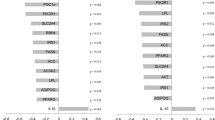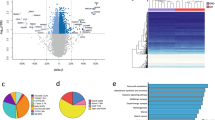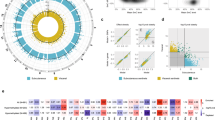Abstract
Obesity may be related to differential DNA methylation and thus to differential expression of key genes in adipose tissue metabolism, such as LPL, ADIPOQ and PPARγ. Using subcutaneous adipose tissue (SAT) from 59 individuals of the European Prospective Investigation into Cancer and Nutrition–Potsdam study, we performed quantitative DNA methylation analysis within the promoters of LPL (LPL-CG1 and -CG2), ADIPOQ (ADIPOQ-CG1 and-CG2) and PPARγ (PPARγ-CG1). We then studied DNA methylation in relation to SAT gene expression, body composition measured using whole-body magnetic resonance imaging, body mass index (BMI), waist circumference (WC) and long-term changes in BMI and WC. For LPL-CG1 and LPL-CG2, higher methylation levels were associated with lower LPL expression, but with higher past WC gain. LPL-CG1 was also positively associated with BMI, WC, and visceral and subcutaneous fat mass. ADIPOQ-CG1 or -CG2 methylation exhibited no association with ADIPOQ expression or with anthropometric parameters. PPARγ-CG1 methylation was significantly higher in individuals with higher visceral fat mass. Among the investigated sites, LPL-CG1 methylation showed the strongest association with gene expression and regional body fat distribution, thereby possibly linking the degree of obesity with major metabolic processes in SAT.
Similar content being viewed by others
Introduction
The contribution of epigenetic alterations such as DNA methylation to obesity or obesity-related comorbidities is not completely understood; however, previous studies have linked measures of obesity to differential DNA methylation in blood cells.1, 2 Comparable investigations for adipose tissue (AT) are scarce, although AT is the major fat-storage site and releases bioactive compounds that modulate insulin sensitivity and systemic metabolism.3
Using human subcutaneous AT (SAT) samples we measured DNA methylation at five CpG positions located within the promoter regions of three genes with perceived impact on metabolic health: (i) LPL—encoding lipoprotein lipase that hydrolyses circulating triglyceride-rich lipoproteins and subsequent fatty acid uptake into AT,4 (ii) ADIPOQ—encoding the insulin-sensitizing hormone adiponectin5 and (iii) PPARγ—encoding the peroxisome proliferator-activated receptor γ, a transcription factor regulating intermediary metabolism and insulin sensitivity.6, 7 These data were used to investigate DNA-methylation levels in relation to SAT expression of these genes, and to body weight, weight gain and body fat distribution.
Materials and methods
In 2009, a random sample of the European Prospective Investigation (EPIC)–Potsdam cohort was invited for assessing body composition and physical activity. Altogether, 816 participants attended this re-examination and fulfilled the inclusion criteria of having no severe disease within 1 year and no surgery within 3 months before the examination. The study was approved by the Ethics Committee of the medical association of the State of Brandenburg (Germany). All participants provided written informed consent. Our study included 60 participants chosen randomly among participants with available peripheral venous blood and SAT samples (n=200). For subsequent statistical analyses, we excluded one participant with missing methylation data.
SAT and visceral AT were measured using whole-body magnetic resonance imaging.8 Trained personnel measured waist circumference (WC), body weight and body mass index (BMI). Using past anthropometric data of the EPIC–Potsdam baseline examination (collected on average 14.5 years before our investigation),9 we calculated 5-year changes in body weight, BMI and WC.
DNA and RNA were extracted from SAT samples using the Qiagen AllPrep DNA/RNA Mini Kit (Qiagen, Hilden, Germany). Extraction of DNA from blood was performed using the DNeasy Blood & Tissue Kit. Quantity and integrity of purified DNA and RNA was analysed using the NanoDrop Photometer (PeqLab, Erlangen, Germany) and the Bioanalyser (Agilent Technologies, Böblingen, Germany). Two micrograms of RNA were reverse-transcribed to complementary DNA (cDNA) using the High Capacity cDNA Reverse Transcription Kit (Applied Biosystems, Darmstadt, Germany).
Chromosomal DNA (500 ng) was treated with sodium bisulfite using the EZ DNA Methylation kit (Zymo Research, Irvine, CA, USA) according to the manufacturer’s protocol. Amplicons were generated using bisulfite-specific primers (Supplementary Table 1). Amplicons were purified using 1 U of ExonucleaseI/Shrimp Alkaline Phosphatase mix at 37 °C for 30 min followed by 80 °C for 15 min. Purified amplicons were subjected to single-nucleotide primer extension with single nucleotide primer extension with ion-pair reversed-phase high performance liquid chromatography (SIRPH) analysis.10 Experimental conduction was carried out as described previously11 (details are given in Supplementary Table 2). SAT samples from three normal-weight and three obese participants were used (i) for selecting potentially informative CpG positions in the candidate genes using methylation data obtained from Illumina 450K BeadChip arrays and NGS-based bisulfite profiling focusing on absence of sequence polymorphism, high variability of methylation levels and association with BMI/gene expression (date not shown), and (ii) for validating SIRPH-based DNA methylation results with Bi-PROF.12 The correlation between both methods was 0.97 (P=0.005) for LPL-CG2, 0.87 (P=0.024) for ADIPOQ-CG1 and 0.94 (P=0.005) for PPARγ-CG1.
SAT gene expression of LPL, ADIPOQ and PPARγ was assessed with real-time PCR using the Applied Biosystems 7500 Fast real-time PCR system with TaqMan technology (ABI, Darmstadt, Germany). The two-step PCR conditions were 20 s at 95 °C, 40 cycles with 3 s at 95 °C and 30 s at 60 °C (5 μl reaction volume, 4 ng template). All samples and controls were run in triplicates. For each amplification cycle, a threshold cycle (Ct) value was obtained, and the ΔCt value was calculated as the Ct difference between target gene and 18S rRNA. Fold upregulation of gene expression compared with weakest expression was calculated using the 2−ΔΔCt method.13
Statistical analysis was performed using the SAS Enterprise Guide, release 9.2 (SAS Institute, Cary, NC, USA). We calculated means±s.d. or frequencies of selected participants’ characteristics. In linear regression models, we used anthropometric parameters or gene expression as dependent variables, SAT methylation as predictor and age and sex as covariates. The resulting β-coefficients indicate the change in the respective dependent variable associated with a 0.1 unit increase in DNA-methylation levels.
Results
This analysis included 18 men and 41 women aged 63.1±8.7 years (Table 1).
In SAT probes, LPL-CG1 methylation correlated strongly with LPL-CG2 methylation (rs=0.63, P<0.001). The correlation between SAT- and blood methylation—available for LPL and ADIPOQ—was very weak (Supplementary Table 3). LPL-CG1 and LPL-CG2 methylation levels were inversely related to LPL gene expression (Table 2). Each 0.1 unit increase in LPL-CG1 methylation was associated with 3.7 kg m-2 higher BMI, 1.1 kg higher visceral AT mass and past weight gain of 1.5 kg per 5 years. SAT-methylation levels between ADIPOQ-CG1 and ADIPOQ-CG2 correlated weakly (rs=0.29, P=0.023), but exhibited no significant association with ADIPOQ gene expression or anthropometric parameters (Table 2). With increasing PPARγ-CG1 methylation we observed significantly increased body fat and visceral AT mass.
Discussion
As epigenetic alterations in AT may be associated with obesity-related phenotypes, we performed quantitative analysis of single CpG methylation within the LPL, ADIPOQ and PPARγ promoters. Among the investigated sites, SAT-methylation levels in LPL-CG1 exhibited the strongest inverse association with gene expression and the strongest positive association with measures of regional body fat distribution.
According to the ‘AT expandability hypothesis’, individuals possess a threshold for preferentially depositing fat in SAT during periods of energy surplus.14 Once this threshold is exceeded, fat is also stored in visceral AT, liver or muscles. Given the gatekeeper function of LPL to direct fatty acid entry into AT,4 LPL activity in AT might decrease as a result of chronic energy surplus and limits in lipid-storage capacity. Indeed, we observed that increased fat was associated with increased LPL promoter methylation along with decreased LPL expression. Although substantially weaker, similar observations were made for PPARγ, a key regulator of AT metabolism,6, 7 suggesting that the metabolic capacity of SAT is linked with obesity-related epigenetic mechanisms.15
Although adiponectin is mainly released by AT, adiponectin levels are decreased in obesity.5 One may speculate that reduced transcription due to methylation of ADIPOQ sites may contribute to this paradox. Yet, ADIPOQ-methylation levels exhibited no association with ADIPOQ gene expression or anthropometric parameters in our study, but for future investigations, methylation sites with a stronger association with gene expression are available.16
This investigation profits from the availability of human SAT samples and in-depth anthropometric phenotyping of study participants. To our knowledge, no previous human study targeted body fat distribution as well as longitudinal changes in obesity markers in relation to SAT methylation within the ADIPOQ, LPL or PPARγ genes. In view of the limited statistical power, the significant association of LPL-CG1 methylation with gene expression and anthropometry is noteworthy. Although we selected three well-established candidate genes of metabolic diseases with exclusive or predominant expression in AT, the focus on only five CpG positions is a limitation. To our knowledge, ADIPOQ–CG2 is the only site with comparable data being reported by others—and its SAT-methylation levels were inversely related to ADIPOQ expression in females.17 As epigenetic marks display cell specificity, any association between DNA methylation and anthropometric markers might have been influenced by changes in cell composition, for example, obesity-induced macrophage infiltration. Although most CpGs of the human genome demonstrate comparable DNA methylation pattern across cell types, homogeneous cell samples are preferable for epigenetic studies.18 Furthermore, our data are correlative and we cannot prove the temporal relationship between the investigated variables. Specifically, obesity may be a consequence of DNA methylation established in early development,19 but weight change may as well alter DNA methylation during adulthood.20 In either case, the regional body fat distribution appears to be associated with differential DNA methylation in genes encoding for key proteins in AT metabolism, thereby possibly linking the degree of obesity with the susceptibility to develop metabolic dysfunction. However, we observed a relation between the methylation status and expression only in one out of five sites.
References
Dick KJ, Nelson CP, Tsaprouni L, Sandling JK, Aissi D, Wahl S et al. DNA methylation and body-mass index: a genome-wide analysis. Lancet 2014; 383: 1990–1998.
van Dijk SJ, Molloy PL, Varinli H, Morrison JL, Muhlhausler BS, members of Epi S. Epigenetics and human obesity. Int J Obes (Lond) 2014; 39: 85–97.
Ouchi N, Parker JL, Lugus JJ, Walsh K . Adipokines in inflammation and metabolic disease. Nat Rev Immunol 2011; 11: 85–97.
Wang H, Eckel RH . Lipoprotein lipase: from gene to obesity. Am J Physiol Endocrinol Metab 2009; 297: E271–E288.
Turer AT, Scherer PE . Adiponectin: mechanistic insights and clinical implications. Diabetologia 2012; 55: 2319–2326.
Derosa G, Maffioli P . Peroxisome proliferator-activated receptor-gamma (PPAR-gamma) agonists on glycemic control, lipid profile and cardiovascular risk. Curr Mol Pharmacol 2012; 5: 272–281.
Evans RM, Barish GD, Wang YX . PPARs and the complex journey to obesity. Nat Med 2004; 10: 355–361.
Wald D, Teucher B, Dinkel J, Kaaks R, Delorme S, Boeing H et al. Automatic quantification of subcutaneous and visceral adipose tissue from whole-body magnetic resonance images suitable for large cohort studies. J Magn Reson Imaging 2012; 36: 1421–1434.
Boeing H, Wahrendorf J, Becker N . EPIC-Germany—a source for studies into diet and risk of chronic diseases. European Investigation into Cancer and Nutrition. Ann Nutr Metab 1999; 43: 195–204.
El-Maarri O . SIRPH analysis: SNuPE with IP-RP-HPLC for quantitative measurements of DNA methylation at specific CpG sites. Methods Mol Biol 2004; 287: 195–205.
Tierling S, Souren NY, Gries J, Loporto C, Groth M, Lutsik P et al. Assisted reproductive technologies do not enhance the variability of DNA methylation imprints in human. J Med Genet 2010; 47: 371–376.
Gries J, Schumacher D, Arand J, Lutsik P, Markelova MR, Fichtner I et al. Bi-PROF: bisulfite profiling of target regions using 454 GS FLX Titanium technology. Epigenetics 2013; 8: 765–771.
Livak KJ, Schmittgen TD . Analysis of relative gene expression data using real-time quantitative PCR and the 2(-Delta Delta C(T)) Method. Methods 2001; 25: 402–408.
Virtue S, Vidal-Puig A . Adipose tissue expandability, lipotoxicity and the metabolic syndrome—an allostatic perspective. Biochim Biophys Acta 2010; 1801: 338–349.
Klimcakova E, Roussel B, Marquez-Quinones A, Kovacova Z, Kovacikova M, Combes M et al. Worsening of obesity and metabolic status yields similar molecular adaptations in human subcutaneous and visceral adipose tissue: decreased metabolism and increased immune response. J Clin Endocrinol Metab 2011; 96: E73–E82.
Houde AA, Legare C, Hould FS, Lebel S, Marceau P, Tchernof A et al. Cross-tissue comparisons of leptin and adiponectin: DNA methylation profiles. Adipocyte 2014; 3: 132–140.
Grundberg E, Meduri E, Sandling JK, Hedman AK, Keildson S, Buil A et al. Global analysis of DNA methylation variation in adipose tissue from twins reveals links to disease-associated variants in distal regulatory elements. Am J Hum Genet 2013; 93: 876–890.
Ziller MJ, Gu H, Muller F, Donaghey J, Tsai LT, Kohlbacher O et al. Charting a dynamic DNA methylation landscape of the human genome. Nature 2013; 500: 477–481.
Godfrey KM, Sheppard A, Gluckman PD, Lillycrop KA, Burdge GC, McLean C et al. Epigenetic gene promoter methylation at birth is associated with child's later adiposity. Diabetes 2011; 60: 1528–1534.
Milagro FI, Campion J, Cordero P, Goyenechea E, Gomez-Uriz AM, Abete I et al. A dual epigenomic approach for the search of obesity biomarkers: DNA methylation in relation to diet-induced weight loss. FASEB J 2011; 25: 1378–1389.
Acknowledgements
We would like to acknowledge the technical support provided by Transgenomic for the WAVE IP/RP-HPLC analyses. Furthermore, we thank Laura V Campos who performed parts of the SNuPE- and Bi-PROF analyses.
Author information
Authors and Affiliations
Corresponding author
Ethics declarations
Competing interests
The authors declare no conflict of interest.
Additional information
Supplementary Information accompanies this paper on the Nutrition & Diabetes website
Supplementary information
Rights and permissions
This work is licensed under a Creative Commons Attribution 4.0 International License. The images or other third party material in this article are included in the article’s Creative Commons license, unless indicated otherwise in the credit line; if the material is not included under the Creative Commons license, users will need to obtain permission from the license holder to reproduce the material. To view a copy of this license, visit http://creativecommons.org/licenses/by/4.0/
About this article
Cite this article
Drogan, D., Boeing, H., Janke, J. et al. Regional distribution of body fat in relation to DNA methylation within the LPL, ADIPOQ and PPARγ promoters in subcutaneous adipose tissue. Nutr & Diabetes 5, e168 (2015). https://doi.org/10.1038/nutd.2015.19
Received:
Accepted:
Published:
Issue Date:
DOI: https://doi.org/10.1038/nutd.2015.19
This article is cited by
-
Rs15285, a functional polymorphism located in lipoprotein lipase, predicts the risk and prognosis of gastric cancer
Applied Microbiology and Biotechnology (2023)
-
DNA methylation in adipocytes from visceral and subcutaneous adipose tissue influences insulin-signaling gene expression in obese individuals
International Journal of Obesity (2021)
-
Coiled-Coil Domain-Containing (CCDC) Proteins: Functional Roles in General and Male Reproductive Physiology
Reproductive Sciences (2021)
-
Chronic stress, epigenetics, and adipose tissue metabolism in the obese state
Nutrition & Metabolism (2020)
-
CpG Methylation across the adipogenic PPARγ gene and its relationship with birthweight and child BMI at 9 years
BMC Medical Genetics (2017)



